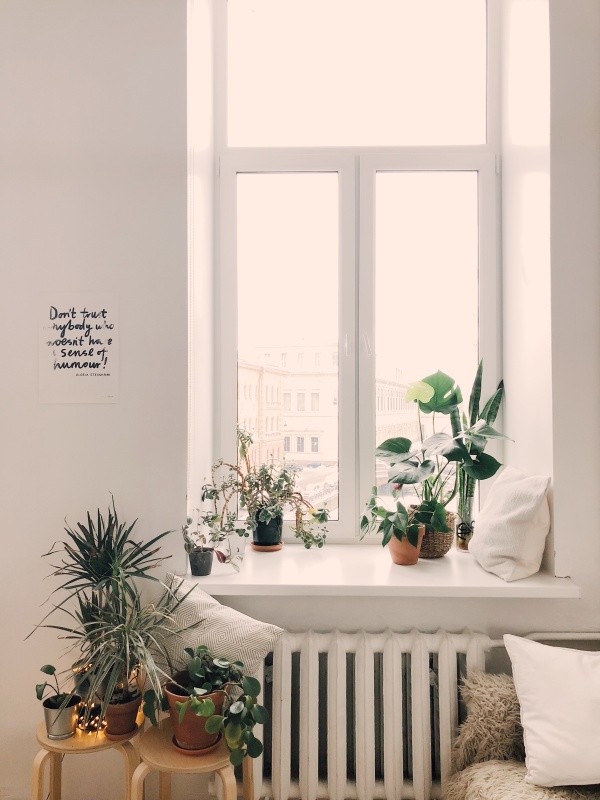
Best indoor plants for clean air
Today we’re going to show you our green side, a part of us that we’ve recently discovered. We’ll be answering the question:
Can plants really help us combat air pollution at home and at work?
We usually don’t realize that harmful substances and toxins can be inhaled in our own homes, workplaces and other enclosed spaces. Of course the effect isn’t as bad as it would be on a busy street but it exists nonetheless.
About 80% of our day is spent indoors (depending on our role), it can often become quite stuffy and badly ventilated. Potted plants improve not only air quality but also our well-being. Which plants are the most effective? How do we choose them?
Read also: Does Electrosmog Contribute to the Development of Diseases?
Plants come to the rescue! - plants good for air
The fact that plants are capable of absorbing carbon dioxide and producing life-giving oxygen in return is something we’ve known since primary school, but did you know that most of the commonly grown potted plants have moisturizing and ionizing properties?
Through transpiration, houseplants evaporate water into the air and can even be used as natural humidifiers!
Britta Riley wanted to grow her own food (in her tiny apartment). So she and her friends developed a system for growing plants in discarded plastic bottles -- researching, testing and tweaking the system using social media, trying many variations at once and quickly arriving at the optimal system. Call it distributed DIY. And the results? Delicious.
Unfortunately, a large amount of plants in the bedroom mightn’t be a good idea as they give off CO2 during the night (as photosynthesis requires daylight) making the air more stifling.[1]
However, there’s no need for concern: some species — mainly succulents and epiphytes — produce oxygen around the clock so it’s all about choosing the right kind of plants.
Another advantage of having plants at home is their ability to absorb harmful substances. Some of the toxic compounds are broken down by the plant itself, whereas others are absorbed from the air, through the leaves and then transported to the roots, where they are processed by soil microorganisms living in symbiosis with the plant in easily accessible organic compounds. These plants were confirmed by the research conducted by NASA and Dr. Bill C. Wolverton in the late 1980s.[2]
Read also: What is immersion in nature and what are the benefits?
10 best air-purifying potted plants - NASA list of air purifying plants:
Don’t hesitate — grow plants!
Even if you can’t imagine yourself living in a miniature jungle or you’re convinced that you don’t have green fingers, try to grow (or tend to) a few less demanding plants such as a spider plant, dracaena or Boston fern.
Enjoy your plant potting!
Find out more:
S. R. Kellert and E. O. Wilson, “The Biophilia Hypothesis”
B.C. Wolverton, “Eco-friendly Houseplants: 50 Indoor Plants That Purify the Air
By introducing a little more greenery into our lives, we can make positive changes to our health and well-being. Do you feel encouraged enough to start growing plants? Or maybe you’re already a plant enthusiast like Britta Riley? Let us know in the comment section!
If you’re interested in sharing your experiences with us or writing a guest post for us, send us an email via hello@mudita.com! Please feel free to get in touch via social media (send us some photos or videos too), you can find us on Facebook, Twitter and Instagram, let’s connect!
To learn more about Mudita, take a look at our website and our other posts. If you enjoyed reading this article, please share and recommend it!
Related stories

Why a Mudita Alarm Clock is The Most Sought-After Gift Of 2025?
Give a meaningful gift this season. Discover why Mudita’s alarm clocks are the top choice for better sleep, calmer mornings & intentional living in 2025.

How Mindful Technology Use Improves Sleep
Improve sleep with mindful tech. Discover Mudita's tips to reduce blue light, eliminate disruptions, and set digital boundaries for a peaceful bedtime routine.

Why You Can’t Sleep (And What to Do About It)
Struggling with sleepless nights? Discover what's keeping you awake & learn practical solutions from Mudita to improve your sleep quality.
Jeśli chcesz otrzymywać najlepsze historie z naszego bloga, bądź na bieżąco z naszymi postępami i otrzymuj powiadomienia o premierach naszych produktów i specjalnych zniżkach.